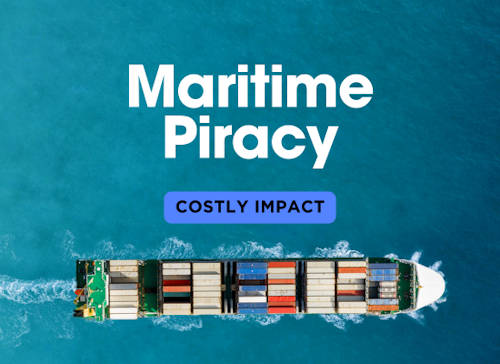The Costly Impact of Piracy on Global Shipping

Maritime piracy continues to be a significant threat to global shipping, particularly in regions such as the Gulf of Guinea, the Somali coast, and Southeast Asia. As pirates employ increasingly sophisticated methods to hijack vessels, the impact on the shipping industry is far-reaching. From financial losses to disruptions in global trade, the consequences of piracy ripple across supply chains, shipping companies, and the global economy. Understanding the multifaceted impact of piracy is crucial for shipowners, governments, and maritime stakeholders. Below is an in-depth table detailing various ways piracy negatively affects global shipping.
| ShipUniverse: The Costly Impact of Piracy on Global Shipping | |||
|---|---|---|---|
| Negative Impact | Cost Implication | Details | Long-Term Financial Effects |
| Higher Insurance Premiums | Increased operational expenses | Shipping companies face significantly higher insurance premiums to cover piracy risks, particularly in piracy-prone regions. | Insurance cost increases reduce profit margins over time, making shipping less cost-effective for operators and customers. |
| Route Deviations | Higher fuel and operational costs | Ships rerouting to avoid piracy hotspots incur longer transit times and increased fuel consumption. | Prolonged delays and higher fuel expenses lead to rising shipping costs, disrupting global supply chains. |
| Crew Safety Risks | Ransom payments and medical costs | Pirates often kidnap crew members, demanding ransoms and causing injury, leading to costly rescue and medical interventions. | High costs for ransom negotiations, rehabilitation, and crew turnover negatively impact ship operators' profitability. |
| Reputation Damage | Loss of business and contracts | Companies operating in high-risk piracy zones face reputational damage if their ships are frequently targeted. | Reputational harm can result in lost business, fewer charters, and reluctance from partners, impacting revenue long-term. |
| Private Security Costs | Increased security-related expenditures | Shipowners often hire private security teams or pay for naval escorts, adding to overall operational costs. | Ongoing security costs reduce profitability and shift resources away from other investments, such as ship maintenance or upgrades. |
| Legal Complexities | Legal fees and regulatory delays | Incidents involving piracy often require dealing with complex international legal frameworks, leading to prolonged legal battles and higher costs. | Unresolved legal issues and regulatory delays can lead to financial losses due to disruptions in shipping schedules. |
| Restricted Access to Trade Routes | Decreased operational efficiency | Piracy limits access to key shipping lanes, forcing vessels to take longer, less efficient routes to avoid high-risk areas. | Shipping delays result in increased transportation costs, which are often passed on to consumers, impacting global trade. |
| Environmental Risks from Pirate Attacks | Fines and environmental cleanup costs | Piracy incidents, especially involving tankers, can lead to environmental damage such as oil spills, resulting in costly cleanups. | Long-term environmental damage can lead to heavy fines and lawsuits, severely affecting financial stability and corporate reputation. |
| Regional Instability | Increased insurance and security premiums | Instability in piracy-prone regions discourages investment and increases operational risk, leading to higher premiums and fewer shipping opportunities. | Continuous regional instability creates uncertainty, which can drive up the cost of doing business, slowing down trade flows and deterring shipping companies. |
| Supply Chain Disruptions | Lost revenue and higher warehousing costs | Piracy causes delays in delivery schedules, particularly for industries relying on just-in-time delivery systems, resulting in revenue loss. | Companies face higher warehousing costs, stock shortages, and potential penalties, reducing overall profitability in the supply chain. |
The Financial Impact of High-Risk Piracy Zones
Shipping companies operating in piracy-prone regions face significantly higher operational costs than those navigating safer waters. The financial burden is multifaceted, with increased insurance premiums, heightened security measures, and potential delays affecting the bottom line. High-risk piracy zones like the Gulf of Guinea and the Gulf of Aden see frequent pirate attacks, forcing shipping companies to invest heavily in protective measures and risk mitigation.
| ShipUniverse: Cost Comparison of High-Risk Piracy Zones | |||||
|---|---|---|---|---|---|
| Zone | Risk Level | Insurance Premium Increase | Average Security Costs (per voyage) | Impact on Delivery Times | Estimated Financial Losses (per year) |
| Gulf of Guinea | High | Up to 50% | $100,000 - $150,000 | Moderate delays due to rerouting or security checks | Substantial financial losses |
| Gulf of Aden | High | Up to 50% | $80,000 - $120,000 | Moderate delays due to naval escort requirements | Substantial financial losses |
| Strait of Malacca | Moderate | 20-35% | $50,000 - $90,000 | Minor delays due to heightened security measures | Moderate financial losses |
| Somali Coast | High | Up to 50% | $120,000 - $180,000 | Severe delays due to rerouting | Very substantial financial losses |
| South China Sea | Moderate | 20-35% | $40,000 - $70,000 | Minor delays due to additional monitoring | Moderate financial losses |
| Caribbean Sea | Low | 5-10% | $10,000 - $30,000 | No significant delays | Minimal financial losses |
Top 5 Piracy-Prone Vessel Types
Certain types of vessels are more frequently targeted by pirates due to their cargo, size, and the areas in which they operate. These vessels face higher security costs, insurance premiums, and potential losses from delays or ransoms. Understanding which vessels are most vulnerable helps shipowners and operators mitigate risks and manage costs effectively.
| ShipUniverse: Top 5 Piracy-Prone Vessel Types | |||||
|---|---|---|---|---|---|
| Vessel Type | Piracy Incident Frequency | Average Loss per Incident | Security Costs (per voyage) | Insurance Premiums | Impact on Charter Rates |
| Chemical/Product Tankers | High | $3 million - $5 million | $80,000 - $150,000 | Up to 50% higher | Lower demand due to higher risks |
| Bulk Carriers | Moderate to High | $2 million - $4 million | $60,000 - $120,000 | Up to 40% higher | Moderate impact on rates |
| Container Ships | Moderate | $1 million - $3 million | $50,000 - $90,000 | 30% - 40% higher | Slightly reduced demand |
| Oil Tankers | High | $4 million - $10 million | $100,000 - $200,000 | Up to 60% higher | Significant reduction in rates |
| Fishing Vessels | Moderate | $500,000 - $2 million | $30,000 - $60,000 | 20% - 30% higher | Minor impact on charter rates |
The Future Outlook of Maritime Piracy and Potential Solutions
As maritime piracy continues to pose a significant threat to global shipping and trade, the future outlook suggests both challenges and promising developments. The shifting dynamics of piracy, such as changing hotspots and more organized pirate networks, make addressing the issue a complex task. However, new technologies, international cooperation, and evolving security strategies are paving the way for potential long-term solutions. Here’s a breakdown of what the future holds and how we are working toward solving this global crisis.
Current Challenges and Emerging Trends
- Changing Hotspots: Piracy remains a major issue in areas such as the Gulf of Guinea and the Southeast Asian waters. While incidents in the Somali Coast have decreased, pirates are now targeting different regions, requiring adaptive responses.
- Increased Sophistication: Pirates are using more advanced technology, including GPS systems and faster boats, to coordinate their attacks, often targeting larger, slower-moving vessels.
- Global Economic Impact: Piracy-related costs, including increased insurance premiums, security expenses, and ransom payments, continue to strain the global shipping industry. This economic burden may increase if new measures are not implemented.
Promising Solutions for the Future
1. Technological Innovations
- Advanced Surveillance Systems: Drones, radar, and night-vision cameras offer better early detection of pirate threats.
- Autonomous Ships: Unmanned vessels reduce the human risk factor and can automatically adjust routes in high-risk areas.
- Real-Time Tracking: GPS and automatic identification systems (AIS) help track ships and coordinate quick responses during piracy attempts.
2. International Naval Cooperation
- Naval Patrols: Joint naval forces from various countries help monitor and patrol piracy hotspots like the Gulf of Aden and Gulf of Guinea.
- Safe Corridors & Convoys: Protected shipping routes with naval escorts ensure safer passage through high-risk areas, reducing the chances of attacks.
3. Private Security Forces
- Armed Guards: Many ships now employ private armed security personnel, which act as a strong deterrent to pirates.
- Best Management Practices (BMP): Following BMP guidelines, such as higher speeds and implementing physical defenses like water cannons, has proven effective in preventing pirate boardings.
4. Enhanced International Regulations
- Legal Frameworks: Countries are working with organizations like the IMO to improve prosecution processes and laws governing piracy.
- Piracy Tracking and Reporting: Tools like the IMB's live reporting system allow for real-time updates on piracy risks, helping ships avoid dangerous areas.
5. Local Community Engagement
- Economic Alternatives: Providing economic opportunities in piracy-prone regions reduces local reliance on piracy as a livelihood.
- Ransom Reduction Initiatives: Efforts to make ransom payments less frequent could reduce the incentive for pirates, diminishing the profitability of attacks.
6. Improved Insurance and Risk Management
- Comprehensive Marine Insurance: Tailored policies that cover piracy-related risks, including ransom reimbursement and cargo loss, help manage financial burdens.
- Risk-Based Premiums: Insurance companies are adjusting premiums based on the security measures taken by ships, encouraging shipowners to invest in preventive actions.
- Piracy Risk Mitigation Services: Insurers offer additional services such as risk assessments and crisis management support, helping shipowners navigate piracy threats more effectively.
The future of maritime piracy presents both challenges and opportunities. While pirates continue to evolve their tactics, advancements in technology, increased international cooperation, and evolving security and legal frameworks offer hope for a safer global shipping environment. By continuing to invest in security, adopting advanced technologies, and working to address the root causes of piracy, the shipping industry can reduce the threat and long-term costs associated with piracy.

Do you have a Maritime Product or Service that may be of interest to Shipowners? Tell us about it here!
Do you have feedback or insights? Please reach out to editor @ shipuniverse.com



